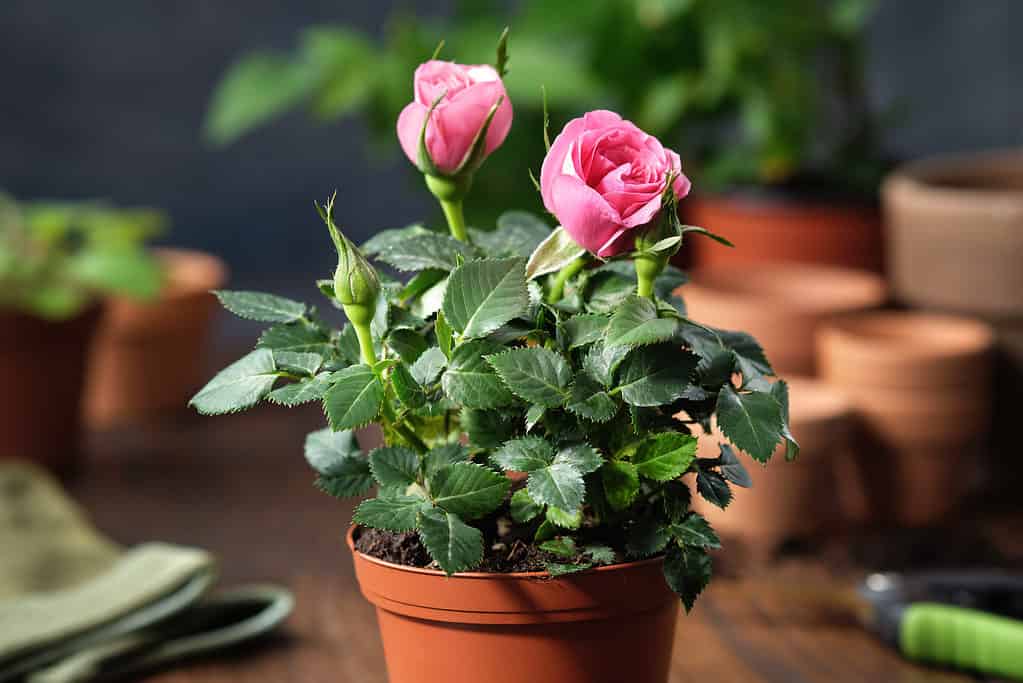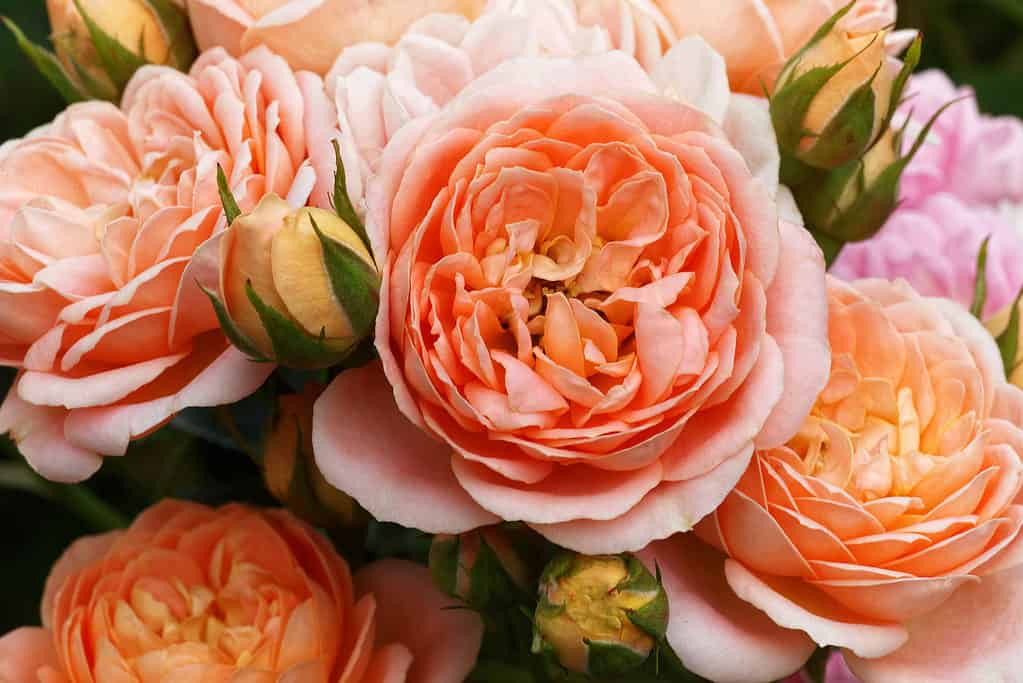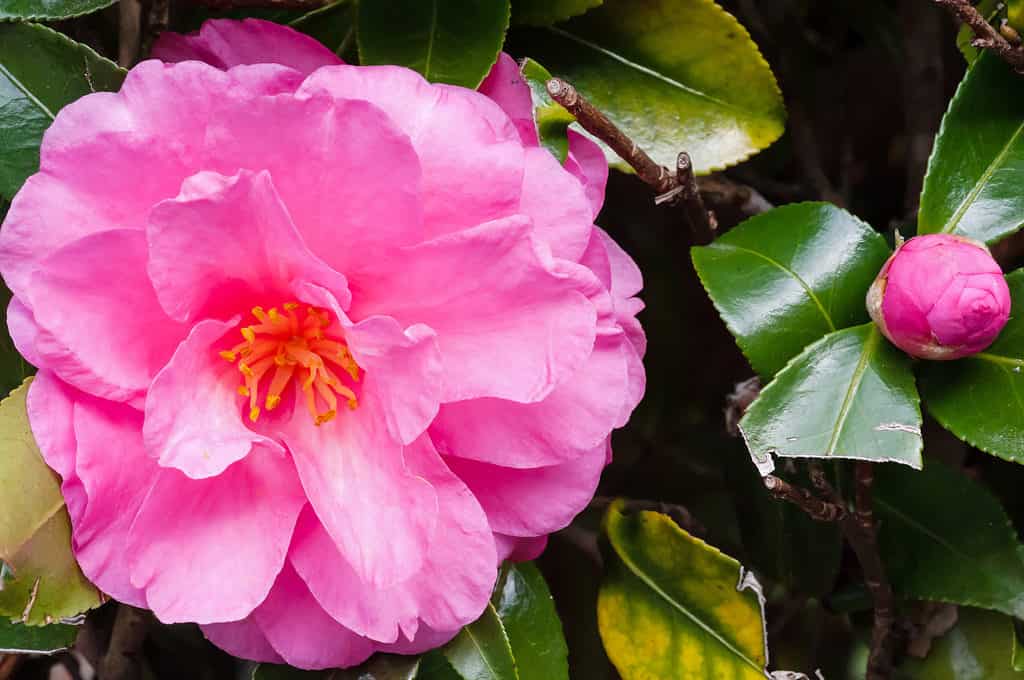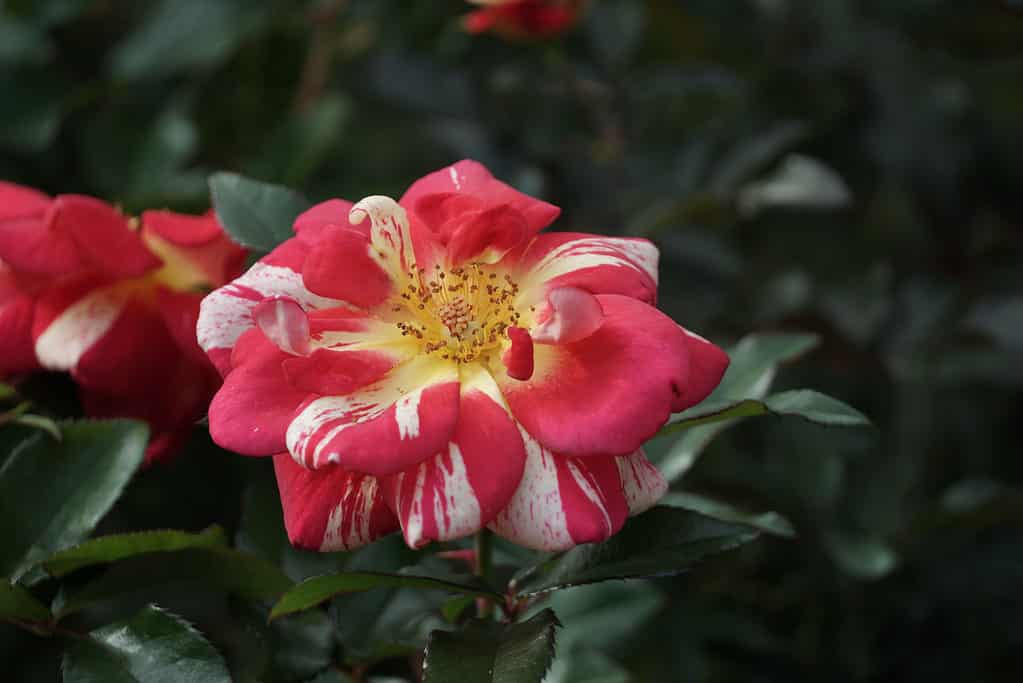Roses are excellent plants for growing in pots because they require minimal space and can be grown in a variety of climates. Planting roses in containers allows you to move them around as needed so that you can easily customize the look of your garden.

Roses are excellent plants for growing in pots because they require minimal space and can be grown in a variety of climates.
©iStock.com/ChamilleWhite
What Type?
English roses are among the most popular varieties to grow in containers, thanks to their shrubby, bushy habit and abundant blooms. Unlike many other potted plants that tend to flower only once or twice during the season, English roses will offer an abundance of fragrant flowers from late spring through early fall. With regular care, pruning, and fertilizing throughout the year, you’ll be rewarded with beautiful blooms all summer long!

English roses are among the most popular varieties to grow in containers offering abundant blooms.
©MaCross-Photography/Shutterstock.com
Ground cover roses are a great choice for potted plants. These roses remain low to the ground and have a beautiful cascading effect when spilling over the edges of your pot. Depending on which variety you choose, it is possible to use them as an attractive border around larger plants within your container garden.

Ground cover roses are great for planting in pots as they create a beautiful cascading effect.
©iStock.com/t:Dragoonphoto
Miniature roses make excellent container plants, as they were specially bred to stay smaller than regular rose varieties. These types of roses are typically more compact and do not grow as large or wide, making them ideal for planting in pots. Additionally, miniature roses are available in a variety of colors and sizes, so you can choose one that best suits your needs.

Miniature roses make excellent container plants, as they were specially bred to stay smaller than regular rose varieties.
©Nancy Salmon/Shutterstock.com
Patio roses are a great choice for those looking to grow a rose that is larger than a miniature but smaller than a standard rose. Patio roses are small-scale floribunda varieties. They have the same spectacular blooms as their larger counterparts but on a more compact and manageable scale. These plants provide gorgeous color and fragrance in any garden or patio setting.

Patio roses are small-scale floribunda varieties with the same spectacular blooms as their larger counterparts but on a more compact scale.
©iStock.com/Wirestock
Polyantha roses are perfect for planting in pots or planters due to their smaller size, making them ideal for those who want a petite display of colorful blooms. This new type of rose is especially well-suited for containers since it produces clusters of small flowers and typically grows on shorter plants that can fit into almost any pot. However, when shopping for polyantha roses, be sure to check the tag carefully so you don’t accidentally purchase a climbing variety!

Polyantha roses are perfect for planting in pots or planters due to their smaller size.
©Patrick Nouhailler / Flickr – License
Potted Roses vs. Bare Root Roses
Potted roses come with a full set of roots, meaning that they are ready for planting. They are typically sold in black plastic planter pots full of soil and can easily be transplanted into larger containers or your garden.
Bare-root roses, on the other hand, do not come with any soil or potting material. Instead, these types of roses are simply bare root systems without soil. They are dormant and must be placed directly into moist soil to ensure successful growth.
Either bare-root or potted rose bushes are perfectly acceptable for your planting project.
When to Plant?
Garden centers usually sell potted roses in early spring. Because they are actively growing, you can plant them any time between April and October.
Bare-root roses become available in late winter and very early spring. They are best planted between January and May when the outside temperatures are above 40° Fahrenheit. They are dormant and will wake up and produce buds after the temperature warms to 60° Fahrenheit.
Tools
You will need the following tools to plant your rose bush in a pot.
- Gardening gloves. Roses have thorns, so be sure to protect your forearms as well.
- Large pot with drainage holes. Roses are tricky to transplant because of their prickly nature, so starting with a larger pot is recommended. A 15-gallon pot that is 18 X 18 inches will suffice.
- Potting soil.
- Compost or aged manure.
- Trowel or hand shovel.
Planting Instructions
First, hold your new rose up against the pot. Your goal is to have the rose end up at the same depth it was in the growing container. The bud union needs to be a couple of inches below the rim of the pot but a couple of inches above the soil. Burying the bud union can cause rot.
Next, start filling the pot with a mixture of compost or manure and multi-purpose potting soil. Press down lightly with your hands as you go to remove air pockets.
Now you can remove the rose from its container. If it is in a plastic pot, try not to disturb the root ball. You can use sharp scissors or a knife to cut away the thin plastic container if necessary. If planting a bare-root rose, carefully remove the roots from the plastic or burlap wrapping.
Place the rose in the new pot and continue adding soil until the bud graft is 2 inches above the soil. Do not fill the soil to the top rim of the pot. Stop two inches from the top to allow room for water.
Now you can give your new rose bush a slow and deep watering and place it in a sunny spot. Roses need a minimum of 8 hours of sunlight per day, so pick a location out of the shade.
Type of Pot
When choosing a pot for your rose bush, it is important to choose one that is relatively large and tall. Pots more than 15 inches in diameter are best. Roses have deep roots, so the taller the container, the better it will be to take advantage of all available nutrients and moisture within the soil.
It’s also important to consider what material your pot is made from, as certain materials transfer heat faster than others. Clay pots help keep the rose’s roots cool. Clay or ceramic pots are also heavy enough that you don’t have to worry about your rose bush tipping over in the wind.
Finally, make sure there are enough drainage holes at the bottom of your pot. These allow excess water and air flow throughout your plant’s root system, which helps promote healthy growth over time!

When choosing a pot for your rose bush, it is important to choose one that is relatively large and tall.
©iStock.com/Nadtochiy
Roses Not Fit For Pots
Technically you can plant any rose in a pot if it’s big enough. But for most of us, space is an issue. Climbing roses tend to grow in every direction at once and aren’t typically suited to growing in pots unless you plan to carefully train them up a trellis or arbor as they grow. Grandiflora roses are tall and have large flowers that bend the stems. These are also not the best choices for potted plants, as they will require staking or cages to keep them tidy.
Some roses are too large for a pot and should be planted directly in the ground. These varieties include shrub roses, which can grow up to 8 feet tall, and heirloom varieties, which grow into thick hedges.
Hybrid tea roses also do not tend to thrive in pots because they prefer their roots to spread out freely beneath the surface of the soil; even though this behavior is seemingly counterintuitive, there is no definitive explanation as to why hybrid teas don’t fare well in containers. Planting these larger rose varieties directly into your garden will save you from having to invest in an excessively large pot – plus, it’s usually considered more beneficial for their growth overall!
The photo featured at the top of this post is © iStock.com/OlgaKorica
Thank you for reading! Have some feedback for us? Contact the AZ Animals editorial team.






